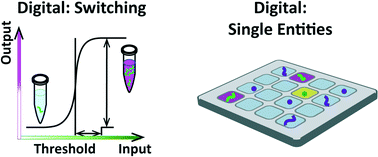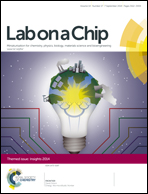Digital biology and chemistry†
Abstract
This account examines developments in “digital” biology and chemistry within the context of microfluidics, from a personal perspective. Using microfluidics as a frame of reference, we identify two areas of research within digital biology and chemistry that are of special interest: (i) the study of systems that switch between discrete states in response to changes in chemical concentration of signals, and (ii) the study of single biological entities such as molecules or cells. In particular, microfluidics accelerates analysis of switching systems (i.e., those that exhibit a sharp change in output over a narrow range of input) by enabling monitoring of multiple reactions in parallel over a range of concentrations of signals. Conversely, such switching systems can be used to create new kinds of microfluidic detection systems that provide “analog-to-digital” signal conversion and logic. Microfluidic compartmentalization technologies for studying and isolating single entities can be used to reconstruct and understand cellular processes, study interactions between single biological entities, and examine the intrinsic heterogeneity of populations of molecules, cells, or organisms. Furthermore, compartmentalization of single cells or molecules in “digital” microfluidic experiments can induce switching in a range of reaction systems to enable sensitive detection of cells or biomolecules, such as with digital ELISA or digital PCR. This “digitizing” offers advantages in terms of robustness, assay design, and simplicity because quantitative information can be obtained with qualitative measurements. While digital formats have been shown to improve the robustness of existing chemistries, we anticipate that in the future they will enable new chemistries to be used for quantitative measurements, and that digital biology and chemistry will continue to provide further opportunities for measuring biomolecules, understanding natural systems more deeply, and advancing molecular and cellular analysis. Microfluidics will impact digital biology and chemistry and will also benefit from them if it becomes massively distributed.

- This article is part of the themed collection: Lab on a Chip: Insights Issue

 Please wait while we load your content...
Please wait while we load your content...